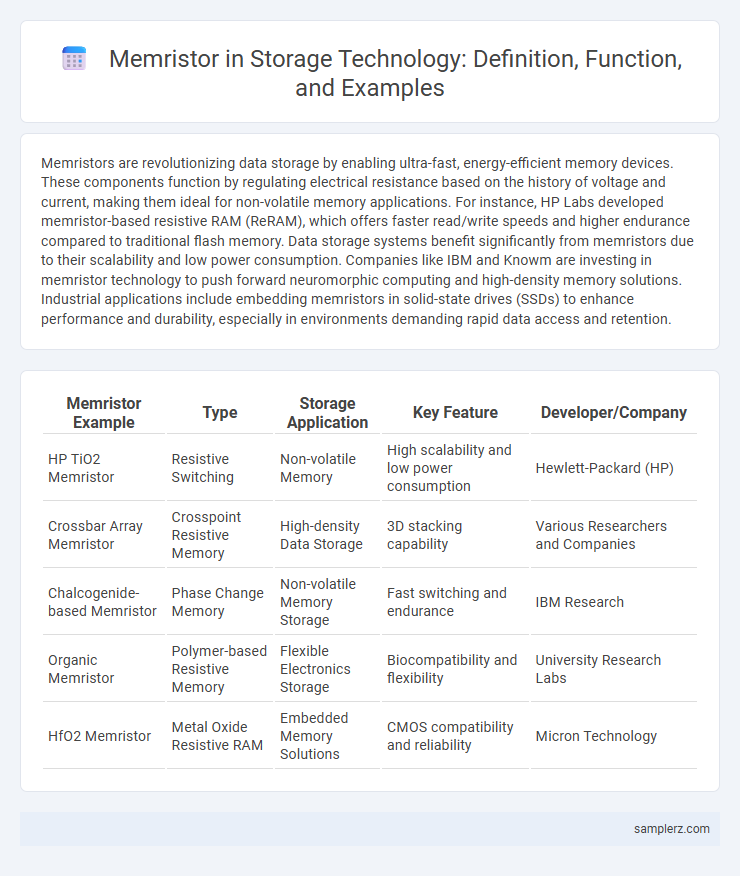Memristors are revolutionizing data storage by enabling ultra-fast, energy-efficient memory devices. These components function by regulating electrical resistance based on the history of voltage and current, making them ideal for non-volatile memory applications. For instance, HP Labs developed memristor-based resistive RAM (ReRAM), which offers faster read/write speeds and higher endurance compared to traditional flash memory. Data storage systems benefit significantly from memristors due to their scalability and low power consumption. Companies like IBM and Knowm are investing in memristor technology to push forward neuromorphic computing and high-density memory solutions. Industrial applications include embedding memristors in solid-state drives (SSDs) to enhance performance and durability, especially in environments demanding rapid data access and retention.
Table of Comparison
| Memristor Example | Type | Storage Application | Key Feature | Developer/Company |
|---|---|---|---|---|
| HP TiO2 Memristor | Resistive Switching | Non-volatile Memory | High scalability and low power consumption | Hewlett-Packard (HP) |
| Crossbar Array Memristor | Crosspoint Resistive Memory | High-density Data Storage | 3D stacking capability | Various Researchers and Companies |
| Chalcogenide-based Memristor | Phase Change Memory | Non-volatile Memory Storage | Fast switching and endurance | IBM Research |
| Organic Memristor | Polymer-based Resistive Memory | Flexible Electronics Storage | Biocompatibility and flexibility | University Research Labs |
| HfO2 Memristor | Metal Oxide Resistive RAM | Embedded Memory Solutions | CMOS compatibility and reliability | Micron Technology |
Introduction to Memristor Technology in Data Storage
Memristor technology in data storage offers non-volatile memory solutions with faster read/write speeds and lower power consumption compared to traditional flash memory. These resistive switching devices enable high-density storage by altering resistance states to represent data bits, facilitating scalable and reliable memory architectures. Memristors are pivotal in advancing neuromorphic computing and next-generation memory systems, enhancing overall data storage efficiency and performance.
How Memristors Revolutionize Storage Devices
Memristors enable ultra-fast data retrieval and energy-efficient storage by leveraging their ability to retain resistance states without power. Their high-density architecture allows for significantly increased storage capacity compared to traditional flash memory. This innovation leads to enhanced durability and reduced latency in solid-state drives (SSDs) and neuromorphic computing systems.
Key Benefits of Memristor-Based Storage Solutions
Memristor-based storage solutions offer ultrafast data access speeds and exceptional energy efficiency, significantly outperforming traditional flash memory. Their non-volatile nature ensures data retention without power, enhancing reliability and reducing system downtime. High density and scalability enable compact storage designs, supporting the growing demands of big data and AI applications.
Memristor Application in Non-Volatile Memory (NVM)
Memristors are revolutionizing Non-Volatile Memory (NVM) by enabling high-density data storage with ultra-low power consumption and fast switching speeds. Their unique ability to retain resistive states without continuous power supply makes them ideal for next-generation NVM technologies such as Resistive Random Access Memory (ReRAM). Integration of memristor-based NVM enhances storage scalability while improving endurance and data retention compared to traditional flash memory.
Real-World Examples of Memristor Storage Implementations
Memristor technology is revolutionizing data storage with real-world implementations such as HP Labs' memristor-based non-volatile memory prototypes, which offer faster read/write speeds and higher endurance than traditional flash memory. Researchers at IBM have integrated memristors into neuromorphic computing systems to enhance data processing efficiency and energy consumption. These advancements demonstrate memristors' potential in enabling scalable, high-density memory solutions for next-generation computing devices.
Memristor vs Flash Memory: Comparative Analysis
Memristors offer significantly faster write speeds and higher endurance compared to traditional flash memory, making them ideal for next-generation storage solutions. Unlike flash memory, which relies on charge storage that degrades over time, memristors utilize resistive switching mechanisms, resulting in lower power consumption and increased data retention. This comparative advantage positions memristors as a promising candidate for high-performance, non-volatile memory devices in advanced computing systems.
Memristor-Driven Neuromorphic Data Storage Systems
Memristor-driven neuromorphic data storage systems leverage memristors' ability to mimic synaptic functions, enabling energy-efficient and high-density memory architectures. These systems facilitate analog data storage and in-memory computation, significantly enhancing processing speed and reducing latency compared to traditional storage technologies. Key applications include pattern recognition and real-time data analysis, where memristor arrays support adaptive learning and fault tolerance in advanced AI hardware.
Energy Efficiency Gains with Memristor Storage
Memristor storage technology offers significant energy efficiency gains by reducing power consumption during data retention and switching operations compared to traditional flash memory. Its non-volatile nature eliminates the need for continuous power to maintain stored information, thereby minimizing energy usage in data centers and portable devices. Research demonstrates up to 90% lower energy consumption in memristor-based memory systems, making it a promising solution for sustainable computing.
Leading Companies Utilizing Memristors for Storage
Leading companies such as HP Labs and IBM are pioneering the use of memristors in non-volatile memory storage, enhancing data retention and energy efficiency. HP's memristor-based memory technology, known as Resistive RAM (ReRAM), offers faster write speeds and higher endurance compared to traditional flash memory. IBM's research into memristor applications focuses on integrating these devices into neuromorphic computing systems to improve performance and reduce power consumption in storage solutions.
Future Prospects of Memristor Technology in Storage Industry
Memristor technology promises to revolutionize the storage industry by enabling ultra-fast, non-volatile memory with significantly higher data density and lower power consumption than traditional flash memory. Emerging applications include neuromorphic computing and advanced cache storage systems, where memristors enhance data retention and speed. Industry leaders like HP and IBM are actively investing in memristor research to develop scalable, energy-efficient memory solutions for future data centers and edge computing devices.

example of memristor in storage Infographic
 samplerz.com
samplerz.com